ASEAN, the Association of Southeast Asian Nations, operates with a unique approach known as the “ASEAN Way.” In 2017, this approach continued to shape the region’s dynamics. This article delves into the core principles of the ASEAN Way and examines its influence on the socio-political landscape of Southeast Asia in 2017.
The ASEAN Way emphasizes consensus-building, non-interference, and a focus on regional cooperation. In 2017, these principles were tested against a backdrop of evolving geopolitical realities and emerging challenges. Understanding the ASEAN Way is crucial for comprehending the region’s political and economic trajectory. The nuances of this approach play a significant role in shaping how ASEAN member states interact and address shared concerns.
The Core Principles of the ASEAN Way
The ASEAN Way isn’t a formally codified set of rules but rather a collection of diplomatic norms and practices. These principles aim to foster peaceful coexistence and regional stability. Some key components include:
- Musyawarah (Consultation and Consensus): Decisions are made through dialogue and compromise, aiming for unanimous agreement. This approach values inclusivity and avoids confrontation.
- Mufakat (Consensus): Decisions require the agreement of all member states. This principle ensures that all voices are heard and fosters a sense of shared ownership.
- Non-Interference: Member states refrain from interfering in the internal affairs of one another. This principle is crucial for maintaining stability and respect for national sovereignty.
- Quiet Diplomacy: Disputes are addressed through discreet negotiations rather than public confrontations. This approach prioritizes maintaining amicable relationships and avoiding escalation.
These principles, while contributing to stability, also present challenges. The need for consensus can sometimes slow down decision-making processes. The principle of non-interference can be criticized for hindering action in cases of human rights violations within member states.
The ASEAN Way in Action: 2017
The year 2017 witnessed numerous instances where the ASEAN Way shaped regional responses to key issues. The South China Sea disputes, economic cooperation, and regional security were all areas where the ASEAN Way’s influence was evident. The emphasis on dialogue and cooperation facilitated progress on several fronts, while the limitations of the approach also became apparent.
Economic Cooperation and the ASEAN Way
In 2017, ASEAN continued to strengthen its economic integration efforts, guided by the principles of the ASEAN Way. The ASEAN Economic Community (AEC) aimed to create a single market and production base, fostering greater economic cooperation and competitiveness.
- Trade Facilitation: The ASEAN Way promoted the reduction of trade barriers and the harmonization of regulations, leading to increased intra-ASEAN trade.
- Investment Promotion: The ASEAN Way created a more favorable investment climate, attracting foreign investment and boosting economic growth.
- Connectivity: Improving infrastructure and connectivity within the region was a key priority, facilitated by the ASEAN Way’s emphasis on cooperation.
 ASEAN Economic Cooperation in 2017
ASEAN Economic Cooperation in 2017
Challenges and Criticisms of the ASEAN Way
Despite its contributions to regional stability, the ASEAN Way has faced criticism. Critics argue that the emphasis on consensus and non-interference can hinder effective action on pressing issues.
- Human Rights Concerns: The principle of non-interference can make it difficult to address human rights violations within member states.
- Slow Decision-Making: The need for consensus can sometimes lead to lengthy and complex decision-making processes.
- Lack of Enforcement Mechanisms: The absence of strong enforcement mechanisms can limit the effectiveness of ASEAN agreements.
Conclusion
The ASEAN Way, with its focus on consensus and cooperation, played a significant role in shaping the Southeast Asian landscape in 2017. While it fostered stability and facilitated economic progress, it also faced challenges and criticisms. As ASEAN continues to navigate a complex and evolving geopolitical environment, adapting and strengthening the ASEAN Way will be crucial for ensuring its continued relevance and effectiveness. Understanding the nuances of this approach remains vital for anyone seeking to engage with the region.
FAQ
What are the key principles of the ASEAN Way?
The key principles of the ASEAN Way include musyawarah (consultation), mufakat (consensus), non-interference, and quiet diplomacy.
How did the ASEAN Way influence events in 2017?
The ASEAN Way influenced regional responses to issues like the South China Sea disputes, economic cooperation, and regional security in 2017.
What are some criticisms of the ASEAN Way?
Criticisms of the ASEAN Way include concerns about its effectiveness in addressing human rights violations, its slow decision-making processes, and its lack of strong enforcement mechanisms.
Have you ever wondered about the challenges of implementing regional agreements in a diverse group of nations? The ASEAN Way provides valuable insights into this complex process. For more information on related topics, check out ase file ps.
Need help understanding how the ASEAN Way has evolved? ase file ps offers additional resources on ASEAN’s history and development.
When you need support, please contact us: Phone: 0369020373, Email: [email protected] Or visit our address: Ngoc Lien Village, Hiep Hoa, Bac Giang, Vietnam. We have a 24/7 customer support team.
